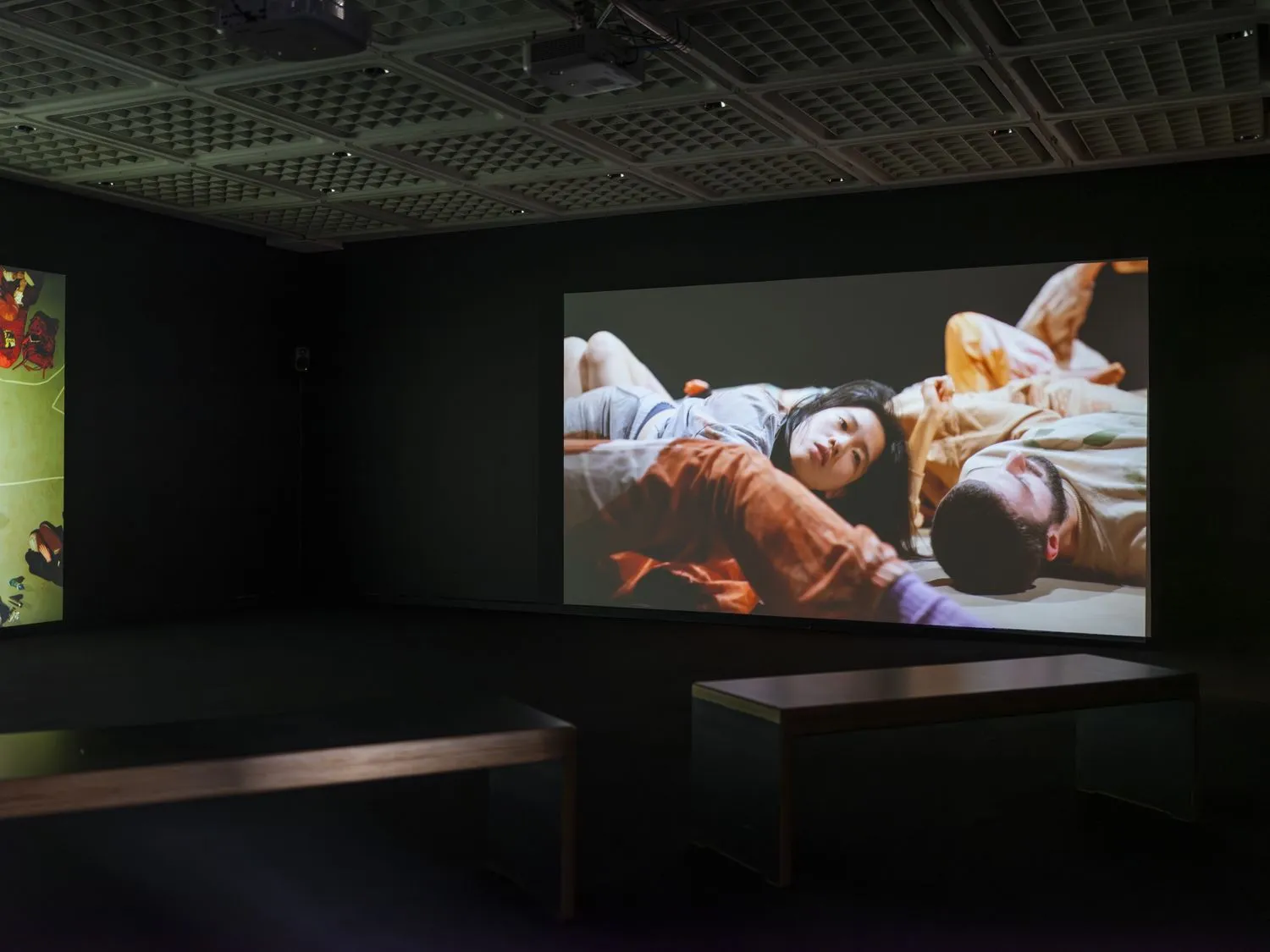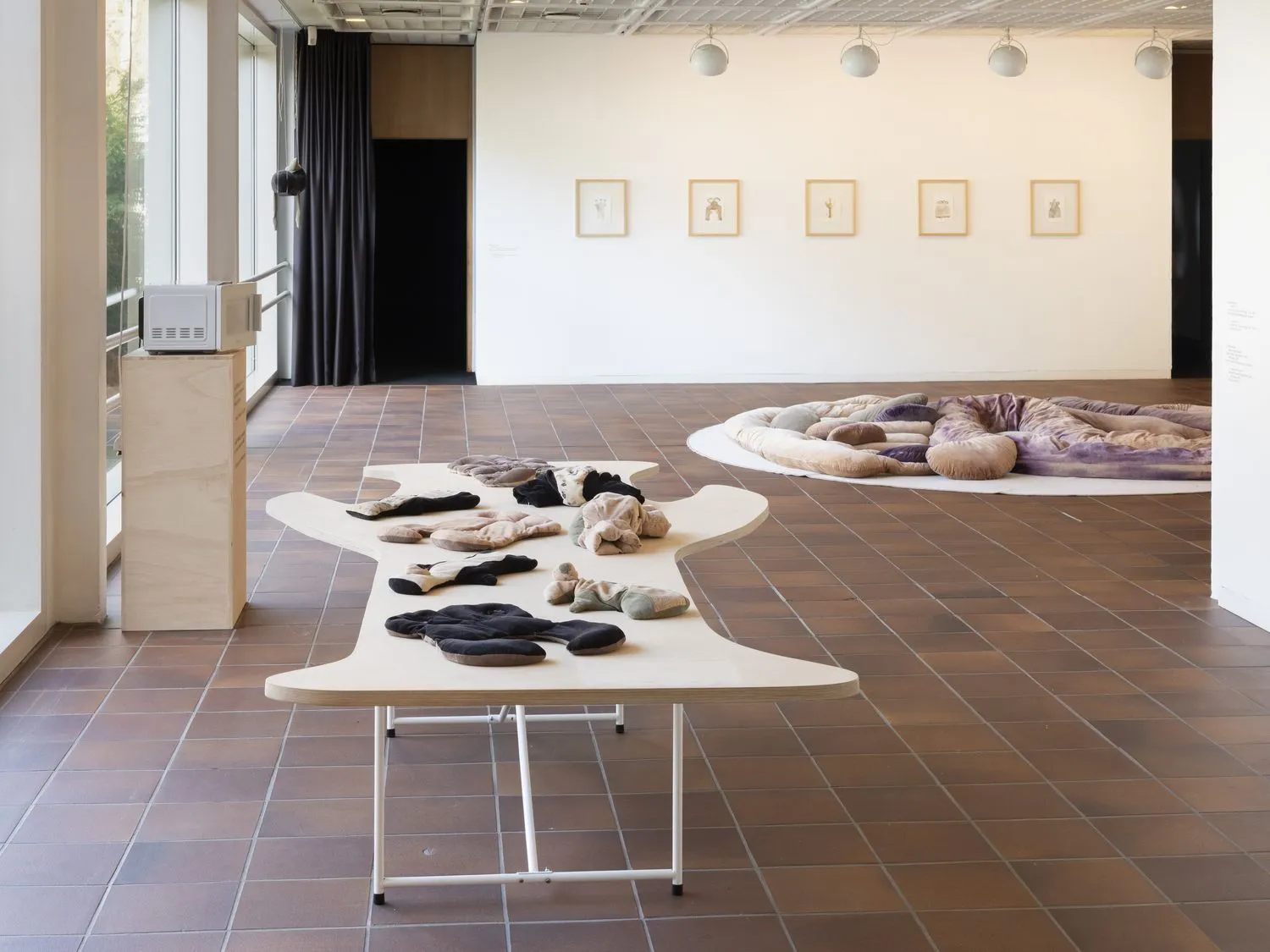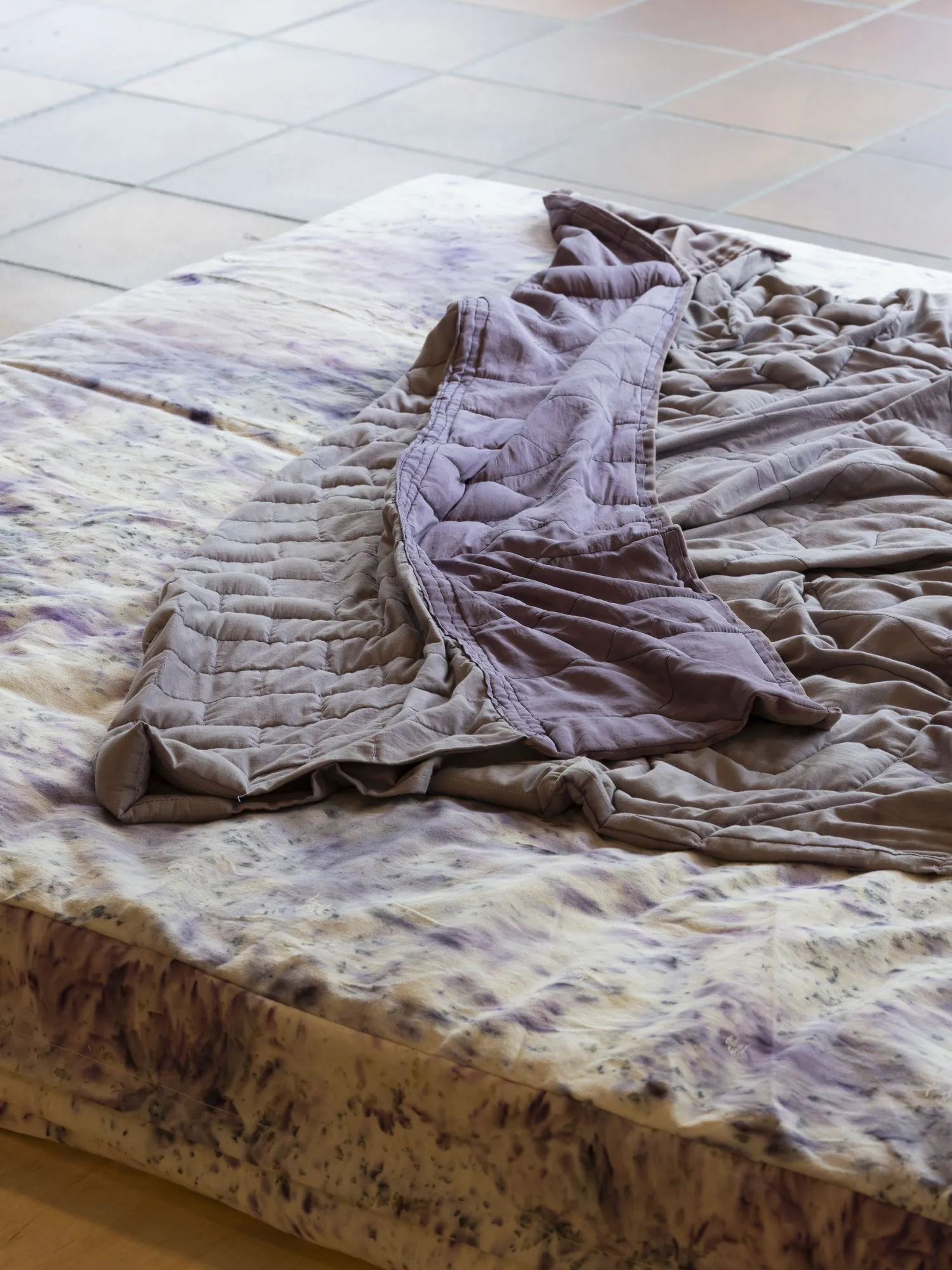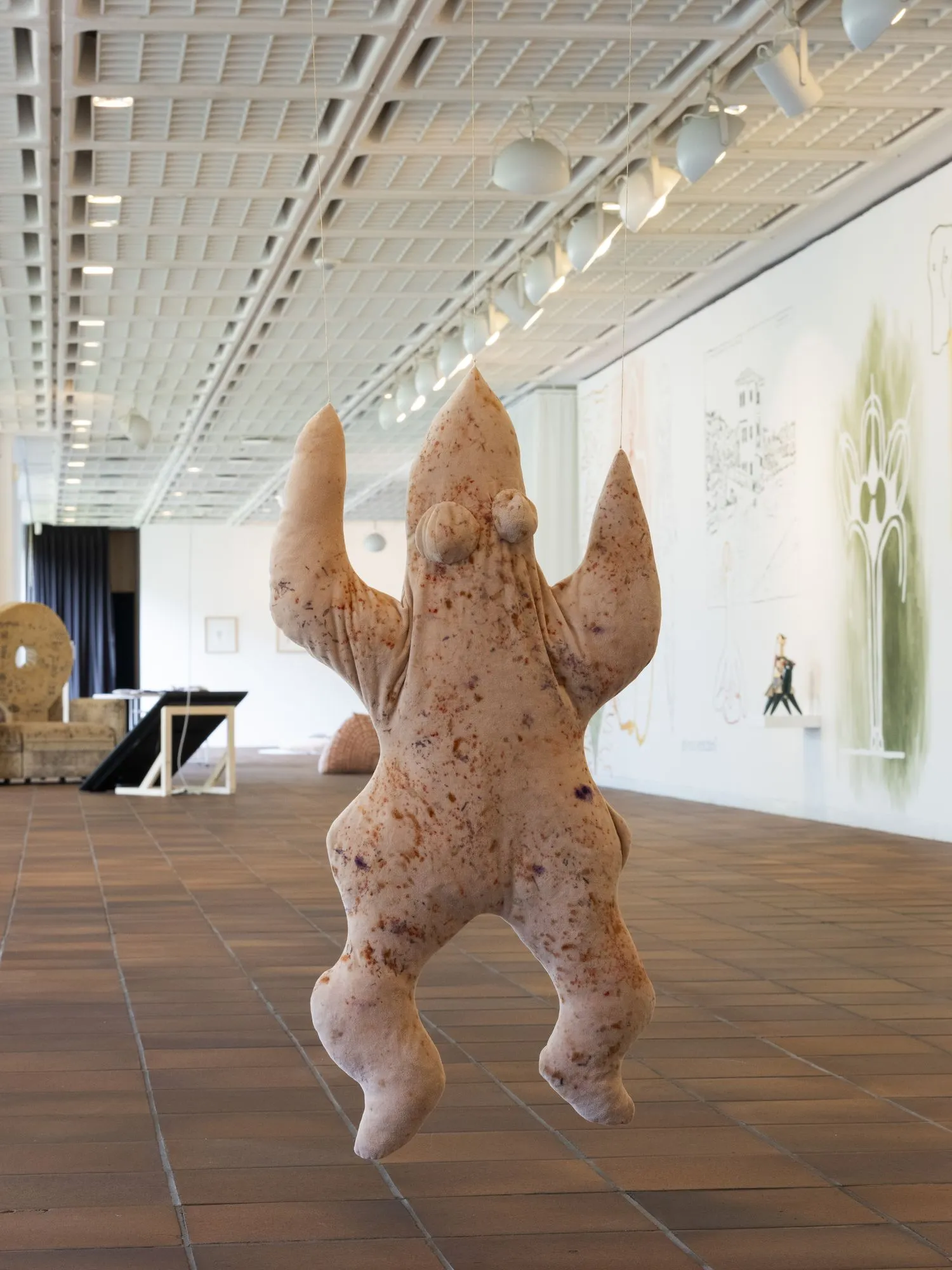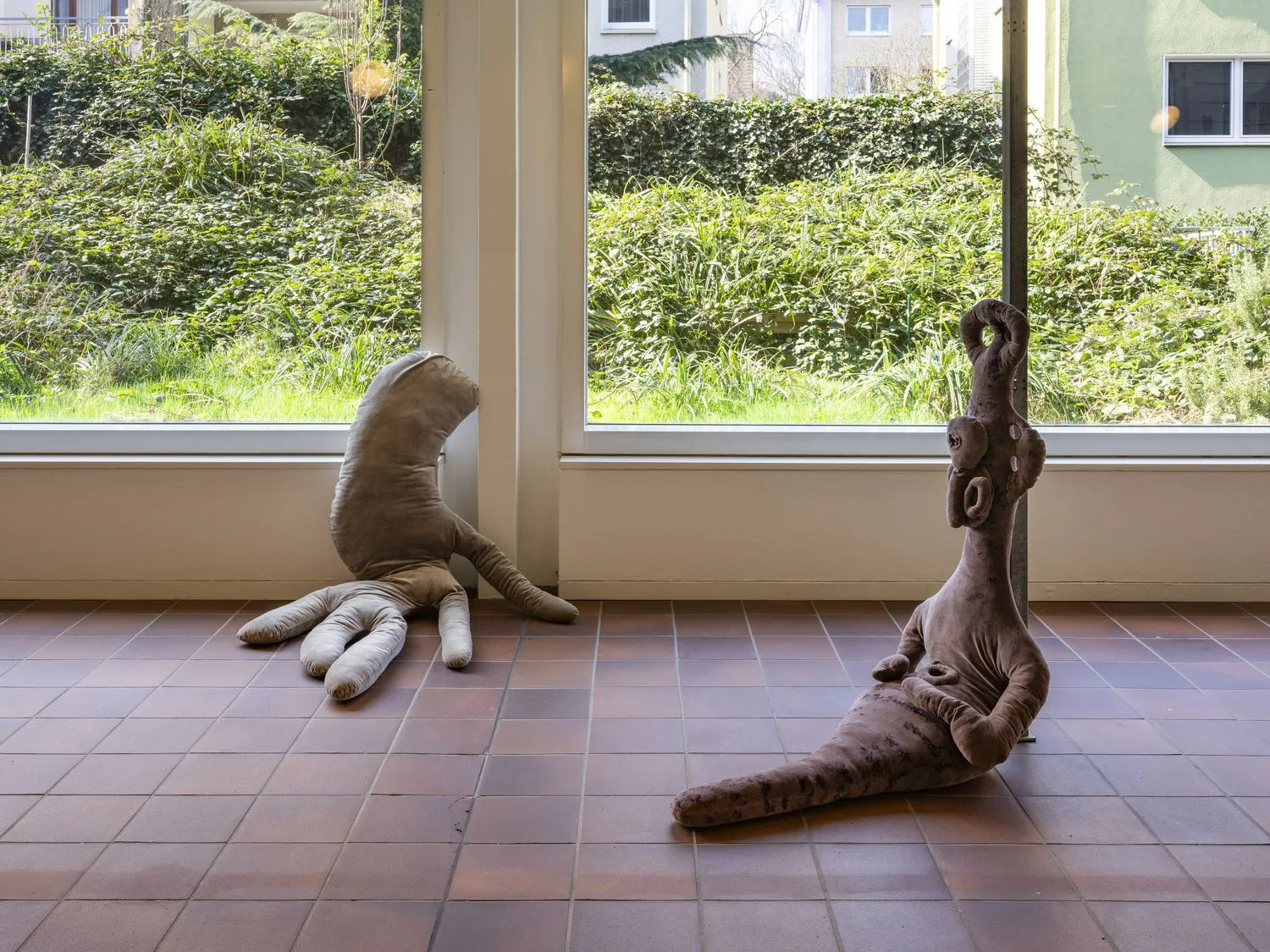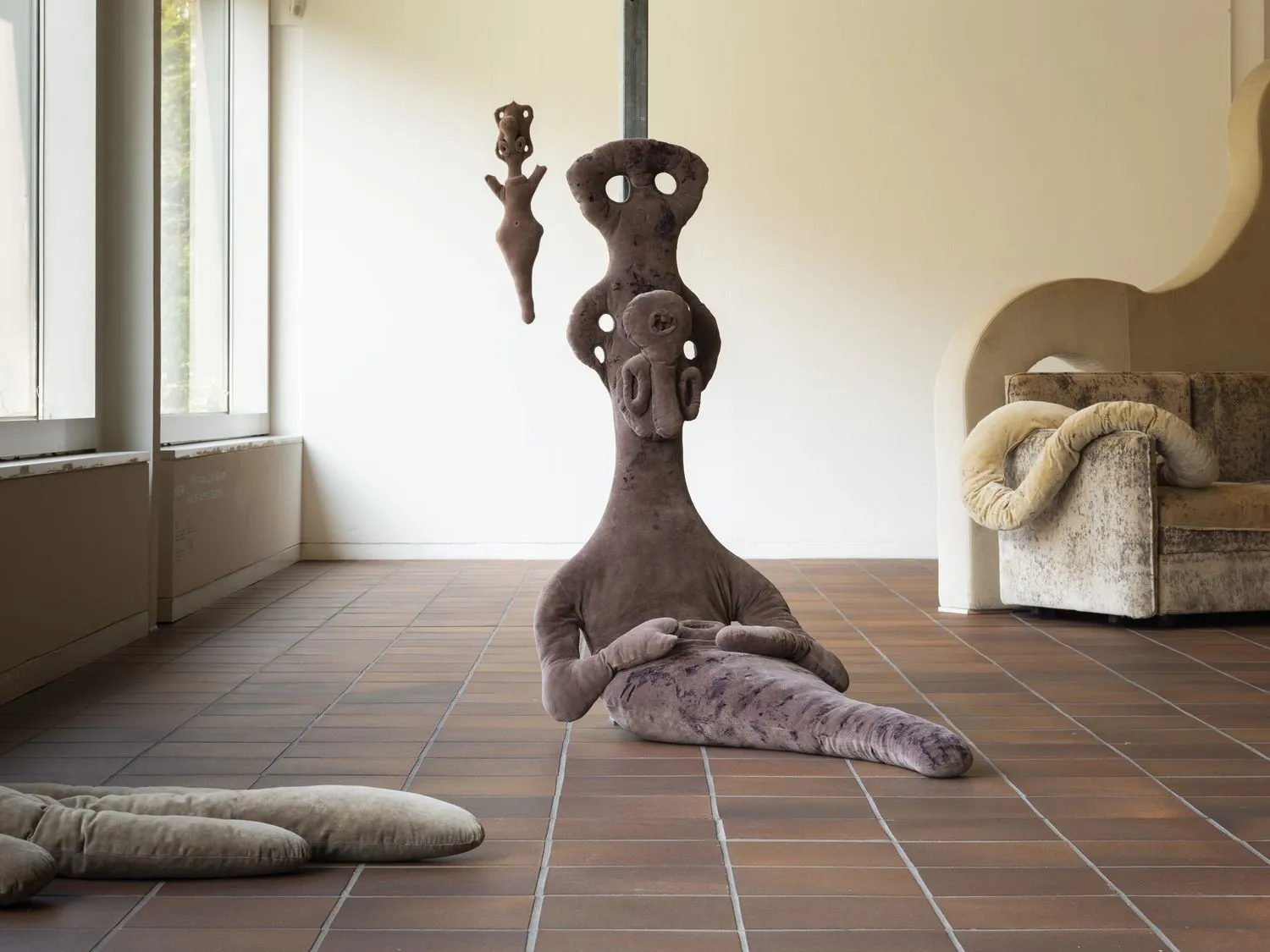 Valentina Karga at Hug Sofa. Foto: Henning Rogge
Valentina Karga at Hug Sofa. Foto: Henning Rogge In an age of mounting environmental collapse, emotional resilience has become a political necessity. WELL BEINGS, Valentina Karga's immersive installation at Kunstmuseum Bochum, responds to this condition not through alarmist spectacle, but by creating a space of tactile refuge. Drawing on her own experiences with eco-anxiety—a chronic dread rooted in the awareness of ecological catastrophe—the Greek-born artist invites visitors into a carefully staged environment of comfort objects and symbolic forms. Weighted blankets, hug-pillows, and oversized plush sculptures populate the exhibition space, transforming the museum into something between a therapeutic clinic and a speculative sanctuary.
But this is not self-care as escapism. Instead, WELL BEINGS proposes somatic repair as a necessary response to collective ecological grief. Karga's installation acknowledges the body as both a sensor and a site of healing—capable of absorbing environmental stress, but also of recalibrating through rest, connection, and affective touch. She reclaims popular tools of nervous system regulation and places them in dialogue with ancient, non-Western cosmologies: many of the exhibition's central sculptures are inspired by prehistoric figurines, their exaggerated proportions and unknowable purposes evoking a time when human life was more intimately entangled with other forces—natural, spiritual, non-human. Many of these artifacts, which date back to between 2000 and 600 BCE, were originally used in ritual or symbolic contexts. Often referred to as fertility idols or ancestral figures, they are often linked to matriarchal or matrifocal cultures—speculative but compelling visions of societies structured around care, reciprocity, and reverence for the earth.
In reimagining these artifacts at monumental scale, Karga doesn't merely historicize care—she reactivates it. What would it mean to attend to the climate crisis not only with data and protest, but with softness, slowness, and somatic attunement? WELL BEINGS does not offer easy answers. Instead, it insists on the importance of emotional regulation as a political tool—one that can help metabolize fear, reframe trauma, and maybe, just maybe, reorient us toward a less extractive way of being. In a culture of exhaustion, Karga makes a compelling case for rest as resistance, and for care as a form of ecological imagination.
In the conversation below, Karga reflects on her personal experience with eco-anxiety and how it shaped the development of WELL BEINGS. She speaks about the emotional and political dimensions of care, the possibilities of collective strategies, and the need to revisit our relationship to the planet as participants in a shared, vulnerable ecosystem.
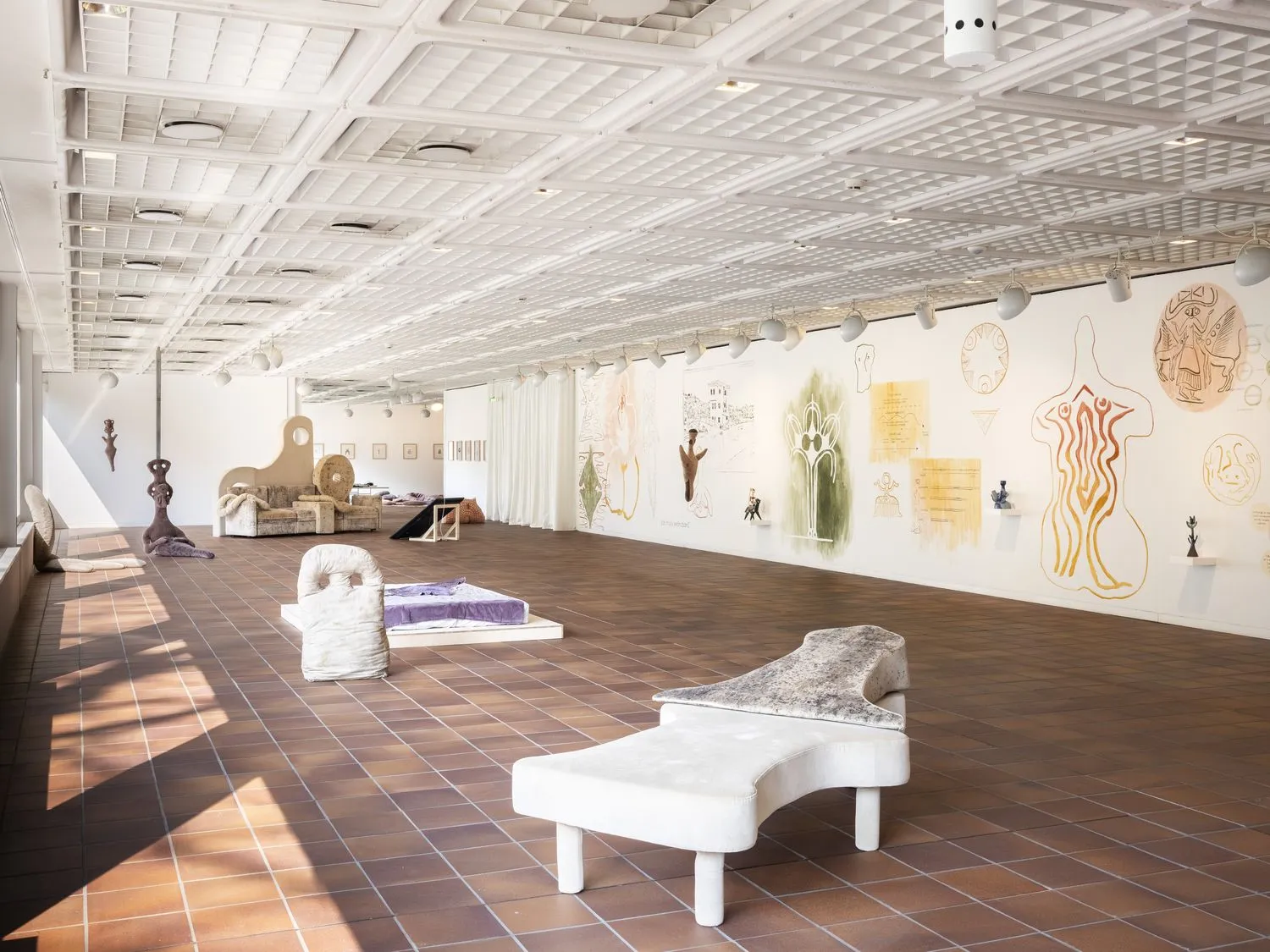
Jelena Martinovic: WELL BEINGS is deeply tied to eco-anxiety, an emotional response many are facing due to the climate crisis. Could you share a bit about your personal experience with eco-anxiety and how it influenced the development of this installation?
Valentina Karga: This exhibition is a conglomerate of things. On one hand, I was researching these prehistoric figurines, which were bringing me a lot of joy and peace. At the same time, I was following all the climate news—which looked, and still looks, terrible—and observing what countries are doing to mitigate climate change. It's not enough, and it's getting worse and worse.
In the exhibition, there's a piece called Doomscroll, a video from my phone recording all the bad news and footage from climate-related disasters around the world. This is basically what I was doing to myself, and I think what many people are doing. Once you start looking at something, the algorithm gives you more of it—as we all know how this goes.
You can go down these rabbit holes, just like how people entered rabbit holes of right-wing conspiracies through anti-vaccine content during COVID. It's an internet phenomenon that reinforces itself, and it’s not compensated by good or hopeful news. When you're spending time on social media, you're also very isolated. It’s a bad constellation of all the factors. So it's not just the bad news, which are very true—it's the isolation, the feeling that you don’t see any hopeful things. Everything starts piling up.
At some point, I realised I was experiencing a lot more anxiety, probably because of this. I started researching what anxiety actually is. We talk about it as a mental health issue, but it’s not just about how you think—it also deeply affects the body. This bodily aspect of anxiety was something I was experiencing for the first time: disrupted sleep cycles, particular pains in my chest or body. It was a very clear crash course on anxiety, and it had a very clear source—the climate news—and no possibility of changing it.
If you have anxiety, a therapist might tell you to identify what you need to change in your life to make it go away. But this is something you cannot control as an individual. What do you do with that? It's like an über-anxiety—something you can't really fight. That was the entry point to the exhibition: this impossible recovery from that kind of anxiety. How do you deal with it?
JM: You've mentioned the bodily experience of anxiety. What made you want to focus on feeling anxiety physically rather than just talking about it or showing it in the work?
VK: I think we are discussing anxiety a lot. There are good people out there trying to do things differently, but we’re not linking it enough to the effects it has on our nervous system and overall health. Mentally pushing yourself only gets you so far. That’s the kind of life I led—or used to lead—where my response to anxiety was action, trying to change things, doing things differently. For example, I changed my whole art practice to work with sustainable materials. That action made me feel good, but only to a certain point.
All of these things then accumulate in the body. There’s this book, The Body Keeps the Score, which talks about how the body remembers everything. We don’t address this enough, and I think it plays a key role in how we deal with this impossible anxiety—something that can’t be solved by action alone.
One of the things that helped me was first to acknowledge it, to recognize it as something normal. That’s why I’m openly talking about it—because I’ve had it, and I’m still dealing with it. It’s not something you just solve and put back into a box. It’s a constant negotiation. I’ve formed a relationship with anxiety, with climate anxiety. I accepted that it’s here. It’s been building up, it made itself present and visible, and it's part of me now.
As much as I try to address it through action and change, it’s also about accepting it as a normal response to what’s happening. That’s what really started the healing process. And I believe in healing. I believe that, just as anxiety exists, healing also exists—and we can hold space for both. It’s not about only wanting to see the good stuff and focus on the positive. That kind of toxic positivity is a real problem in our society.
There are people whose social media is the complete opposite of mine—only positivity, dances, cats, nice food, nice places. When that is the only thing you see, it becomes a form of escapism. Can we acknowledge the tragic realities and at the same time, still enjoy the nice things life has to offer?
JM: Exactly. And it's also about confronting the gaslighting—this idea that people affected by it are overreacting, that their response is somehow too much.
VK: Absolutely. Learning about gaslighting was also key for me. Realizing I'm not the crazy one for having this response. Everybody else is crazy for lying to me and people like me—telling us we're overreacting or too sensitive. But this is exactly what's happening. It’s real. It has huge consequences. It's accelerating, it's coming fast, and it’s very unsettling. Many people are suffering, many are dying. You can't deny this by only watching the nice parts of the world that some of us still have access to.
And honestly, everyone who doesn't feel this anxiety is either in denial or deeply narcissistic for suppressing it—because it exists. That suppression and denialism, and the gaslighting that follows—first to oneself and then to others—is also a form of climate anxiety.
But the body can't lie. Once you start becoming aware of the body, you can't deny it anymore—because you feel it physically, once you tune in.
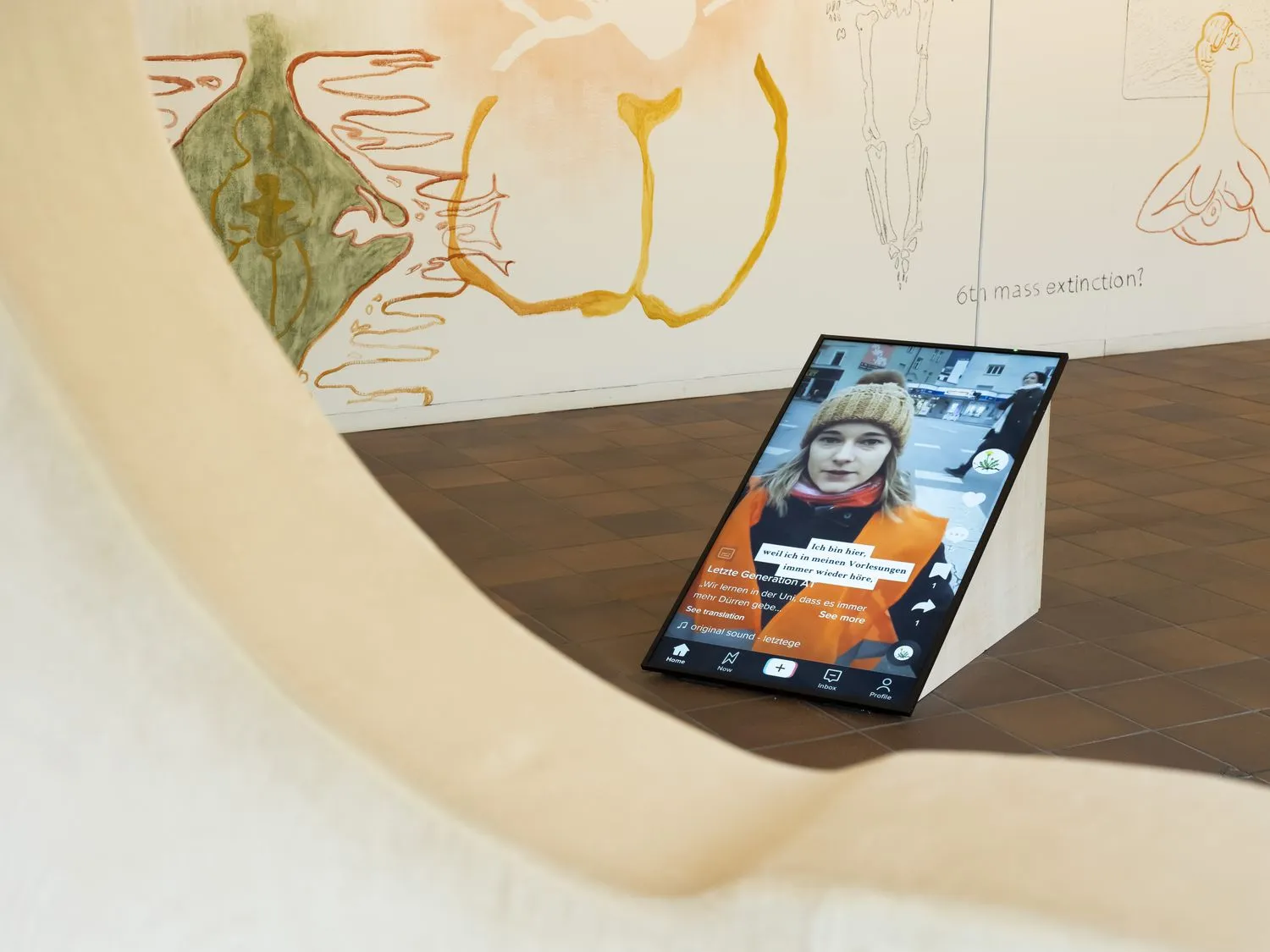
JM: Your research into prehistoric figurines plays a central role in WELL BEINGS. What do these ancient objects symbolize for you, and how did they shape your view of our connection to nature today?
VK: As I mentioned earlier, I was researching these figurines, and I know them quite well because I studied in Volos, Greece, where the local archaeological museum has many of them. A number were unearthed by the contested archaeologist Maria Gimbutas, whom I studied.
She was controversial in the 1960s and ’70s because she argued that these figurines—with their prominent vulvas and breasts—reflected a time when societies were more matrilineal, when women held more importance. According to her, there was no patriarchy, and therefore no war. It was a peaceful time. That was her thesis, and while I found it inspiring, many in her field rejected it, saying it lacked scientific grounding. But I think what she was really doing was artistic research. She brought together folklore, mythology, and archaeology, tracing patterns and drawing broader conclusions. And through this work, she contributed to second-wave feminism.
Today, of course, feminist and gender struggles are still very present. But what I feel is our broader, more urgent struggle is that between humans and nature—not just men versus women. That human versus nature struggle is what I wanted to explore through these figures.
In them, I see not only human characteristics but also animal traits, and even plant-like or alien elements. Some seem insect-like or bird-like—these hybrid forms between human and other beings. I thought: if Gimbutas contributed to second-wave feminism, maybe now it's time to use these figures to contribute to a more post-human, post-anthropocentric worldview.
That's why I found it so compelling—this idea that such a view is already within us, embedded in our prehistoric DNA. We just need to remember our prehistoric selves, from thousands of years ago. Maybe there’s still a seed in us that can reconnect with that.
JM: How has her work influenced your approach to both the ecological crisis and the theme of healing in WELL BEINGS?
VK: I'm very inspired by post-human theory—especially thinkers like Donna Haraway and Rosi Braidotti, and other women in contemporary philosophy. Their work is deeply connected to feminist theory. There's already a strong link there: women, historically othered and exploited as reproductive bodies for centuries, mirror the way we’ve treated the Earth—the ultimate reproductive body.
What we do to the planet reflects what we've done to other humans and their habitats. That relationship—our way of relating to Earth and nature—is where healing begins. Healing becomes the only way forward.
This perspective helped me understand the intersectionality of these struggles. It's not just about feminism—it also includes the fight against racism. We've othered groups of humans, forcing them to bear the consequences of a rapidly growing world with unsustainable demands. That, to me, is at the core of the crisis we're facing today.


JM: Your installation invites people to physically engage with it, combining hug pillows and weighted blankets alongside these big prehistoric figurines. How do you think this physical interaction helps visitors confront or process eco-anxiety or connect to the space?
VK: Yeah, so I wanted this to be very embodied and very tactile—partly because, as I mentioned earlier, The Body Keeps the Score was a big revelation for me. But also because I felt the exhibition is quite intellectual; you have to read and know a lot to engage with it on that level. I was thinking about all the visitors who are more into the aesthetic experience of art—children, elderly people, or those not interested in discourse-oriented work.
So I wanted to create something that could speak to them as well. And my biggest proof that it works is when children visit the exhibition—they immediately know what to do. They take off their shoes and often jump into the cushions. That's really the most validating response for me.
JM: It's interesting what you said about children being instinctively drawn to the tactile aspects of the installation—they just dive in. I assume adult visitors are more hesitant to engage. What do you think this difference in engagement reveals about how we, as adults, relate to comfort and vulnerability in the context of eco-anxiety?
VK: The hesitation among adults is partly because, in a museum, you're usually not allowed to touch the art—so people have to unlearn that in my exhibitions. But you’re right, it's also about not wanting to drop the façade. It’s quite vulnerable to admit, "Yes, I feel this anxiety too," especially in public. At home, it's easier to mask it, but in a shared space, it becomes more difficult to hide.
This also ties into another conversation I find really interesting, which comes from the field of neurodivergence. There's been a huge increase in diagnoses recently—not because more people are suddenly autistic or neurodivergent, but because more people feel safe enough to unmask and acknowledge it. In the same way, unmasking our true emotions—especially difficult ones—is something we’re not taught to do in our culture. It's still taboo to some extent.
JM: In WELL BEINGS, we're surrounded by calming forms, but there's also a sense of crisis. We've already talked about the doomscroll, which is quite relatable, but there are also visual references to climate disasters in your mural. What led you to create this tension between comfort and crisis?
VK: Yes, that tension is very intentional—and it's something that often comes up in conversations with the museums showing the work, since WELL BEINGS is a traveling exhibition. Initially, there was only the doomscroll as a reminder of the crisis. But in this version, I've added drawings of two climate-related floods: one in my hometown in Greece and another nearby in Germany. Both were devastating, with serious loss.
For me, it's important not to strip away the reality of what we're facing. The crisis is there—we can't just pretend it isn't. But at the same time, we have tools to cope. These tools go beyond hugging soft objects; they're about coming together in a shared, public space where we can acknowledge what's happening, talk about it, and support each other. Sharing resources and emotional support is part of that.
My secret wish with this exhibition was to turn the museum into a kind of climate café—a safe space where people can gather and talk about their climate-related emotions. I believe this should be part of our public infrastructure. Especially as the crisis escalates, we can't expect everyone to access expensive, specialized therapy. We need publicly funded spaces where people can process what they're feeling. That's the deeper proposal behind WELL BEINGS.
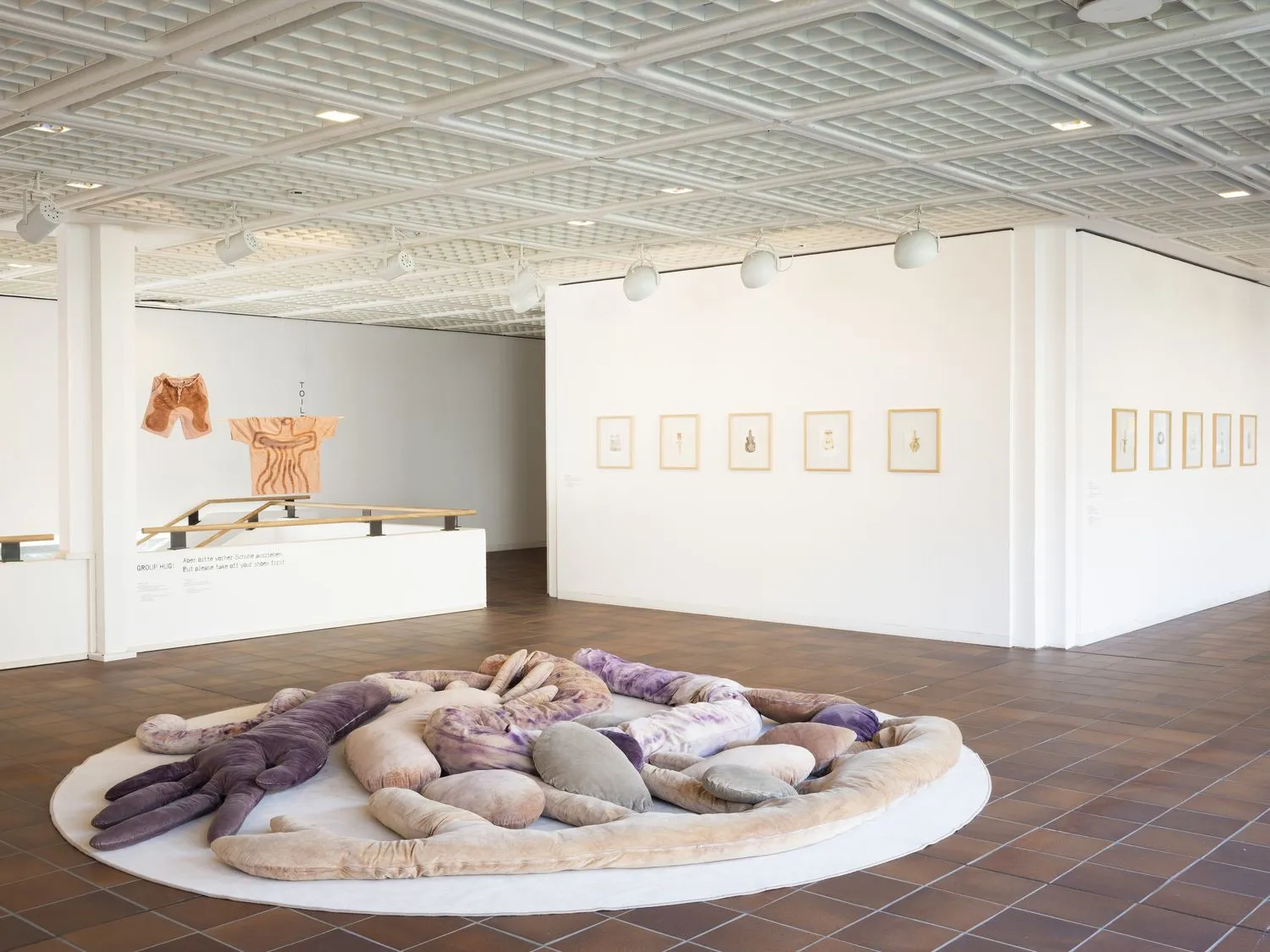
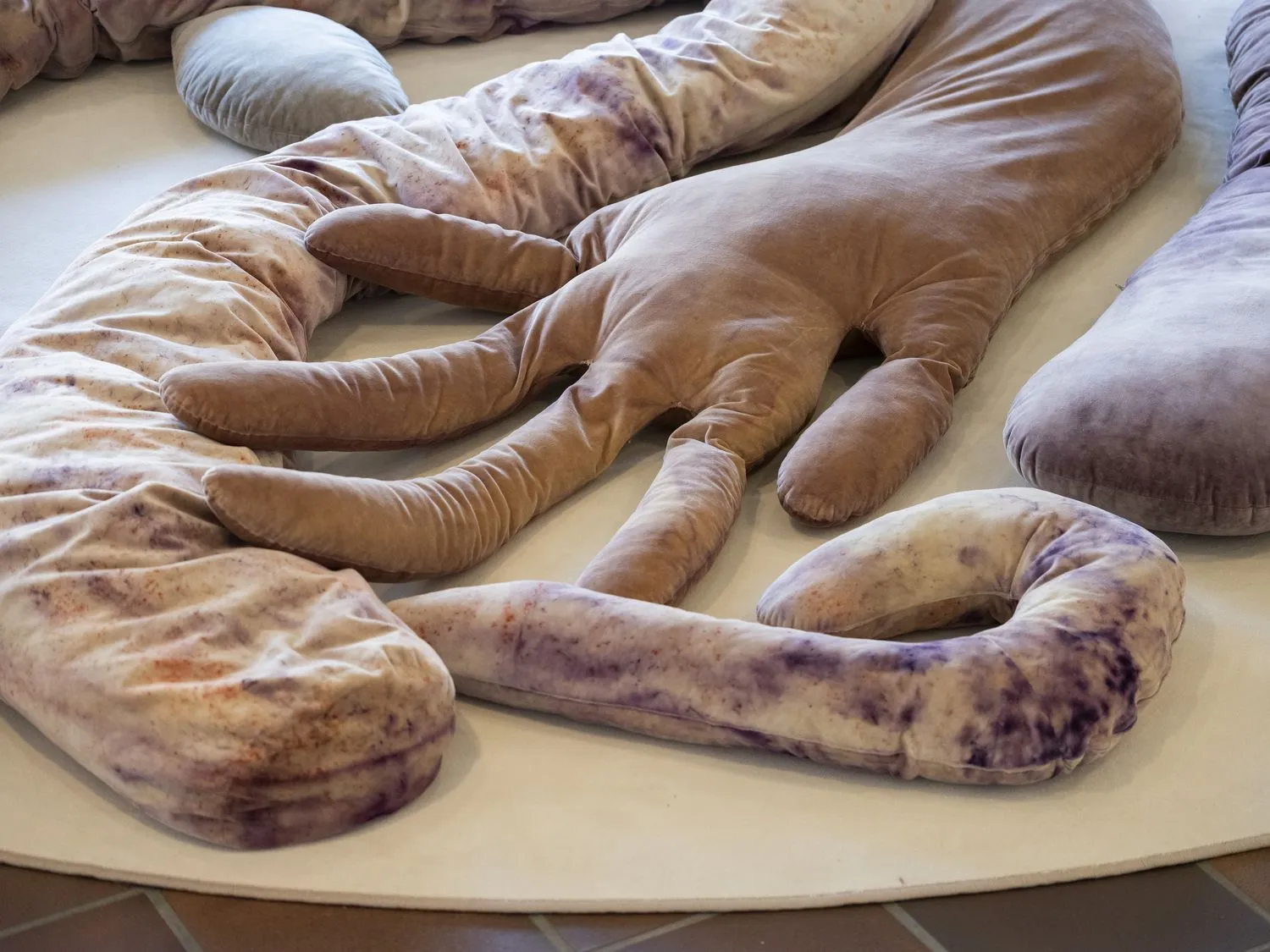
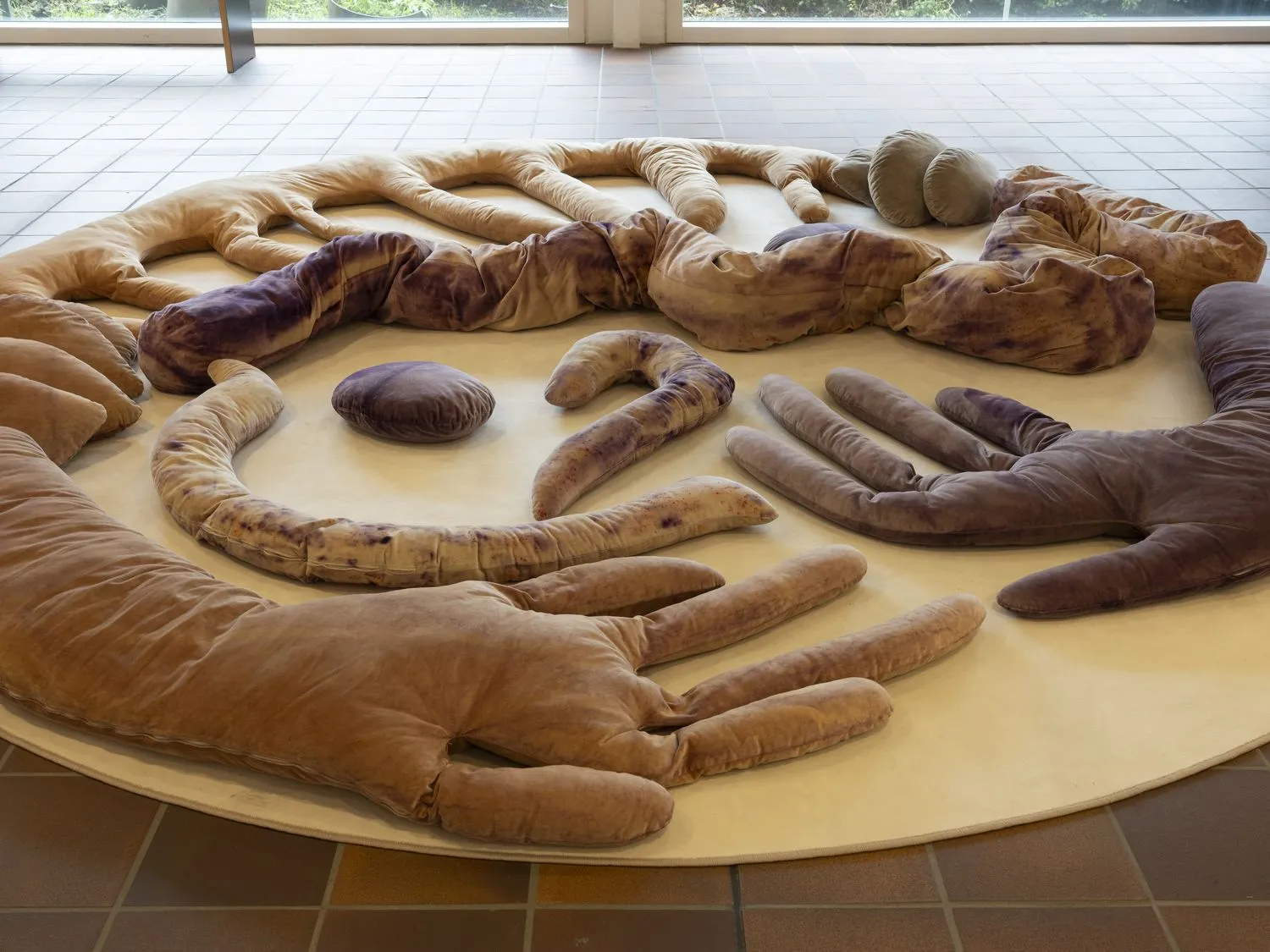
JM: In your video Adaptation, we see students moving from individual anxiety to a more collective entanglement. What were you hoping to open up by shifting the focus from individual to collective experiences?
VK: This video came out of a workshop I did with choreographer Polixeni Angelidou, and larp designer Nina Runa Essendrop, and my students from HFBK in Hamburg. Together, we created fictional characters who suffer from climate anxiety. Fictionality here was a way for the students to acknowledge feelings they might not dare to admit directly. It’s easier to face difficult emotions when you’re pretending to be someone else.
The characters they created were trying to prepare for a future that made them anxious, looking for material solutions. But then things changed—the characters became climate refugees, forced to leave many of those tools behind. In the end, what remained as the real support was community. Even without material resources, what you still have is your humanity—and your ability to support one another.
JM: How do you see the importance of collectivity within the crisis we're living—climate, political, and otherwise?
VM: I think this is exactly what will determine how the future plays out. We’ve reached a point where it's too late to mitigate enough to stay below 1.5°C of warming. Disasters will happen, and they'll come faster and faster. There are two main political tendencies in response to this. One is: save yourself and your own. What Trump is doing in the U.S. right now is basically large-scale prepping for the rich—securing all the remaining oil and rare earth mineral resources for themselves. That, to me, is the most misanthropic way of dealing with this crisis. It's like: we don't care about anyone else, we just want to survive and keep our material comforts, keep flying, keep eating meat, and not give up anything. So they believe they need all the remaining resources to preserve their lifestyle.
The opposite model is: we're all in this together. We'll sacrifice what we need to, so we all have a chance to survive—and to do it in a humane way. Not letting people die or suffer elsewhere so we can keep burning carbon. That's a political choice. I hope more and more people start to see this clearly: we are now at the point of making that choice, and it needs to be a radical one. There's no middle ground anymore. I think the distinction between these two paths will only become more stark. Personally, I find great solace in community. It's a much better world to fight for than one where a few survive alone with their carbon luxuries. Who wants to live in that world? I really don't understand that mentality.

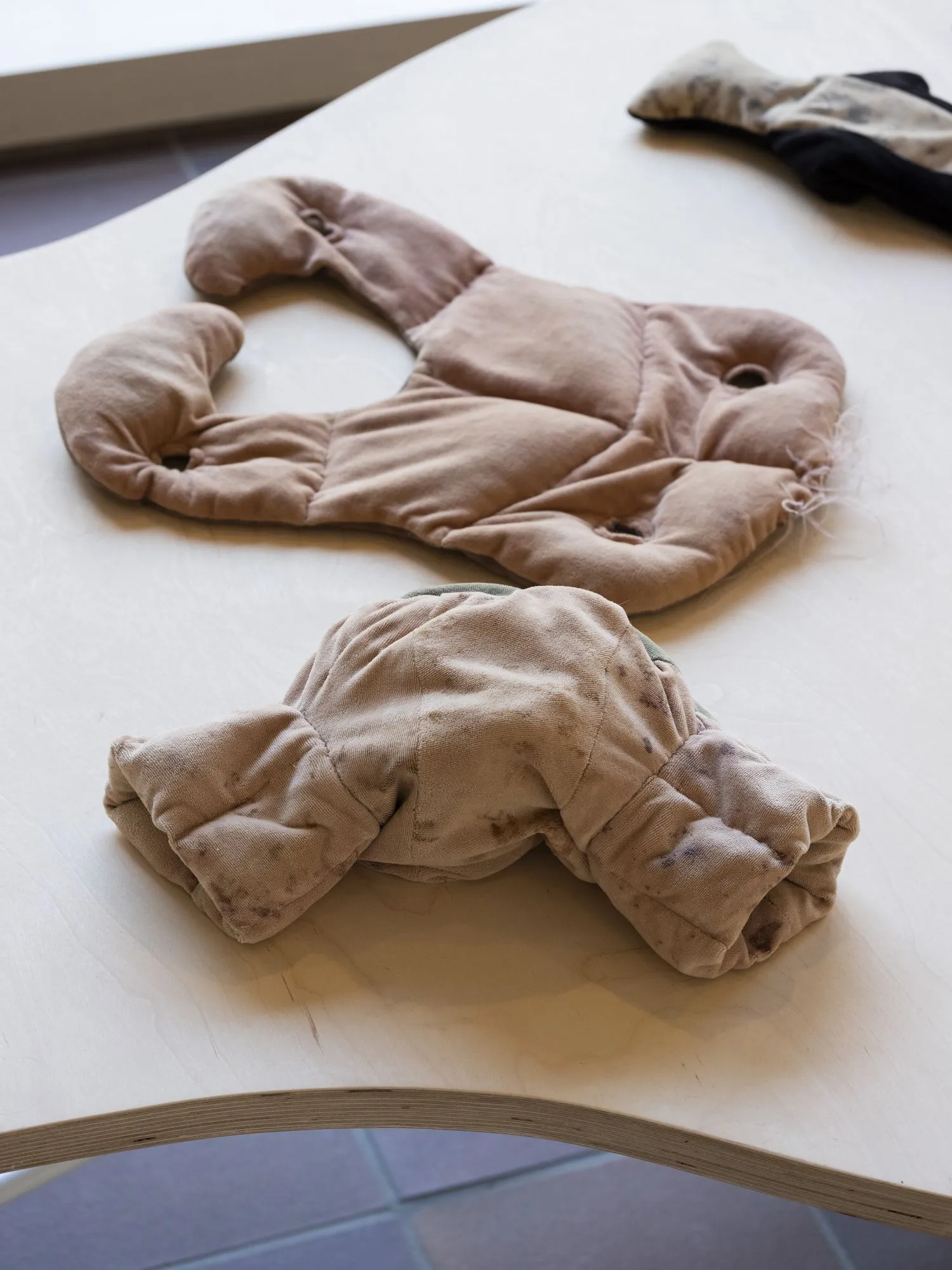
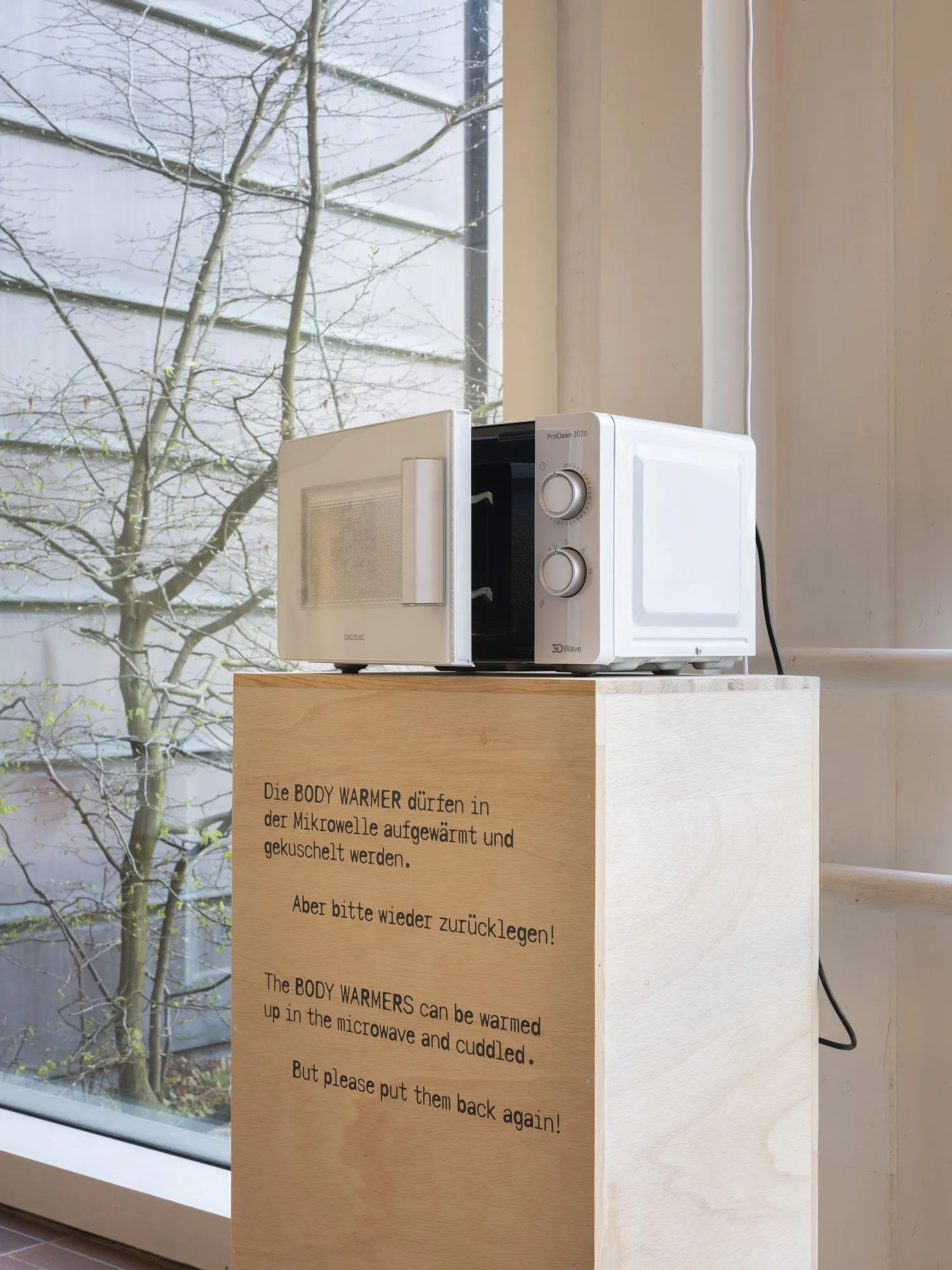
JM: Yes, I fully agree with you. So, to wrap up: in your mural, grieving, distancing, and action overlap as ways of engaging. Do you think emotions like these—especially in the context of care—can become a political strategy? What kinds of action do you see emerging from them?
VK: Yes, this comes from the work of a Finnish researcher I incorporated into the mural—Panu Pikhala—who is an expert on climate emotions. He gives many workshops and writes about how we emotionally navigate the climate crisis. The way I understand it, there are three key modes: grief, distancing, and action. At some point, when you're overwhelmed with anxiety or grief, you also need some distancing. You need space to process things alone—and that’s very different from the kind of disengagement we talked about earlier. It’s an honest, human need.
But then you also need action. You need to come together, strategize, hold assemblies, and ask: what can we do to influence real politics—not just through voting, but by being active citizens? There are many good things happening. And I hope more people will feel called to act, especially as the urgency becomes clearer. Right now, in Serbia, you're experiencing massive protests. In the U.S., too.
And as I've said, the struggle is intersectional. These mobilizations will also affect climate policy, immigration policy, and more. For me, all these struggles are connected. There’s grief, too—in losing even the basic idea of democracy, fighting to remember what it means. That’s also a loss we have to process. But then: fight back. You rest, you grieve, and then you gather strength to return.
Rest is vital—we can't be in permanent fighting mode. Many activists burn out, and it's completely understandable. It's sad that people like Trump never seem to need a rest from their narcissism. (laughs) It fuels them endlessly. And that's so unfair.

